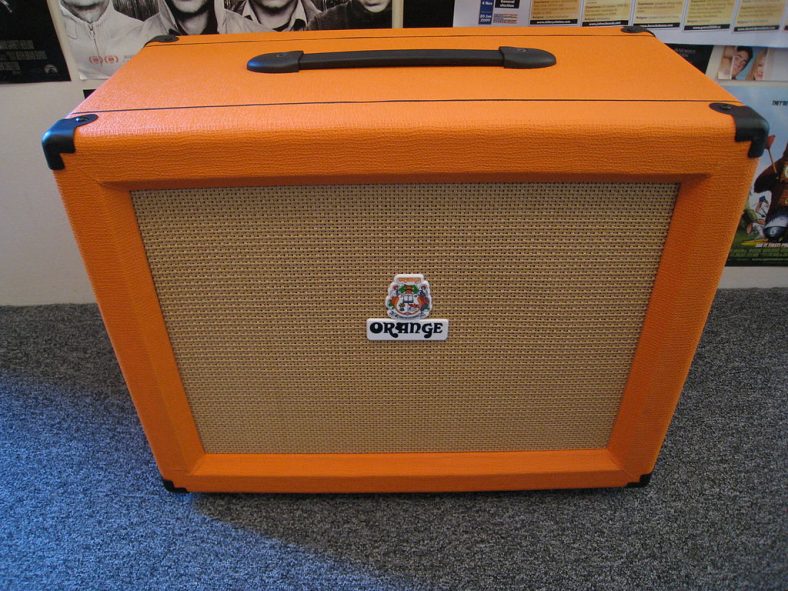Struggling to decide whether a 1×12 guitar cabinet is what you need? You’re not alone. Here, we’ll explain the advantages and disadvantages of a 1×12 cabinet, so you can make the right choice for your setup.
So don’t worry any more – this guide will help you find the best match for your rig!
The 1×12 guitar cabinet is a simple but effective way to upgrade your sound. It’s relatively compact and portable, making it easy to transport, yet it provides plenty of power and projection. A variety of sizes are available, but they all offer unmistakable tone – especially when the right combination of speakers and power amplifiers are used. With its versatility, low cost, and increased volume potential, the 1×12 cabinet is a popular choice for most guitarists.
In this guide, we’ll discuss the advantages and disadvantages of the 1×12 guitar cabinet. We’ll talk about why it’s such a great option for practice as well as for gigging or recording. We’ll also go over different models available on the market so you can make an educated decision when purchasing one for yourself. Finally, we’ll explain how to get the best sound out of your new cabinet by sharing various tips and tricks from professional players around the world.
Advantages of a 1×12 guitar cabinet
A 1×12 guitar cabinet is an excellent choice for both home and studio environments due to its size and sonic qualities. These cabinets are easy to transport from place to place, making them an ideal option for gigging musicians as well. Here are several advantages of using a 1×12 guitar cabinet:
- Compact size – 1×12 guitar cabinets are significantly more compact than other types of amplifiers, making them easier to store and transport. That makes them perfect for small recording studios, apartments, and intimate live music venues.
- Excellent sound quality – Although 1×12 cabinets have a small footprint, they offer great sound quality and clarity at medium or higher volumes, making them ideal for all kinds of musical styles.
- Versatility – Unlike some larger amps and speaker cabinets which offer limited tonal options, a 1×12 allows you to shape your sound just the way you want it with a variety of onboard effects such as chorus, reverb and overdrive.
- Durability – As these amplifiers are made with high-quality materials such as heavy duty plywood paneling for the enclosure, metal grille and protective corners; they tend to be robustly constructed ensuring longer performance life-span with little maintenance needs along the way.
Portability
One advantage of a 1×12 guitar cabinet is that it provides greater portability than larger size cabinets in both weight and size. A 1×12 cabinet typically weighs around 25 to 40 pounds, whereas a 4×12 cabinet or even a 2×12 cabinet can weigh upwards of 80 or 90 pounds. The increased weight of these larger cabinets makes them more difficult to transport and bring to performances.
In addition, the cabinet itself is typically made with smaller dimensions that make it easier to store and fit inside a vehicle compared to the larger cabinets. If you are looking for an amplifier head to pair with your 1×12 speaker cabinet, then you should consider portability when making your purchase as some heads can be very heavy as well.
Size and weight
The size of a 1×12 guitar cabinet is typically much smaller and lighter than a comparable 4×12 or other traditional guitar speaker cabinet. This makes the 1×12 an especially attractive option for traveling musicians, as it can easily fit into small spaces and won’t add too much weight to your cabinet.
Additionally, the smaller size means that the cabinet will also produce less sound pressure, despite having the same watt rating as a larger speaker. This can be beneficial for certain musical settings as less sound pressure is often desirable in recordings or quiet acoustic venues.
Convenience for travel
Guitarists looking to travel with their music often prefer the convenience of the 1×12 guitar cabinet, since it offers a smaller size and weight compared to 2×12 or 4×12 cabinets. A 1×12 cabinet typically includes one 12-inch speaker, which is powered by an internal amplifier. Therefore, players don’t have to haul around additional units — just the single cabinet. Additionally, the sound of a 1×12 generally has more focus than larger cabinets that use multiple speakers. This can give players a stronger center image and enable better clarity at higher volume levels.
One added bonus for players who appreciate compact size for travel purposes is that there are some 1×12 models available with built-in reverb or digital effects. So instead of having to carry more gear on tour with you, these types of cabinets give you all you need in one single unit — including good tone! The main downside here is that even though these devices produce quality sound for their size, they will not provide as much low frequency response as larger cabinets that use multiple speakers in tandem with each other. Of course, this issue can be remedied somewhat by using a subwoofer speaker system (which can be either sold separately or built in).
Sound
- Sound -The primary advantage of a 1×12 cabinet is the improved sound. Many guitarists prefer the warmer, more resonant sound produced by the larger speaker vibrating in a single-speaker speaker cab. Since a single 12” speaker can be moved around and still sound good, it offers great versatility and convenience compared to two or four 10” speakers sharing the same space. Additionally, commonly available models come with an additional horn driver that adds a little more “bite” and “top end” to their tone.
The tight bottom end and focused top end of a 1×12 cabinet can make it less muddy while still giving you crunchy distortion tones and tight lead sounds, depending on your settings and amp.
There are some drawbacks to having just one speaker, however, such as losing some of the low end or higher number of lows that are usually associated with multiple speakers when using distortion settings or heavy overdrive. Some players may also experience feedback if they push their amp too hard in smaller venues; this is due to the lack of low-frequency dampening from multiple speakers found in other multi-speaker cabs like 2x12s or 4x12s . Generally speaking, if you are playing clubs or venues with PA systems (where usually you will mic your signal for house amplification), this should not be an issue.
Clarity
The sound of a 1×12 guitar cabinet compared to other types of guitar cabinets ultimately comes down to clarity. The most noteworthy advantage of this setup is that the single speaker enlarges the sound and creates a circular waveform. This waveform allows for more clarity with higher frequencies, resulting in additional resonance that can reach far even with the lower wattage output.
The 1×12 guitar cabinet can handle bigger bass response as well, providing a full balanced tone that really stands out when performing live or on recordings. However, when playing clean tones in particular, this setup will also produce sounds with distinct highs and lows without any hint of distortion or crackling sounds from overdrive/distortion-based effects.
Focus
The main benefit of selecting a 1×12 guitar cabinet is that it offers deep and focused bass sound. This makes the sound more rich and full-bodied, which is great for recording. In addition, the size of the speaker enclosure allows players to move around with their rig, and they’re not limited to having a large set up in one spot.
It also produces more high end clarity compared to other types of cabinets due to its smaller size and the shorter distance between drivers. This means that it will be easier for you to cut through the mix without being too loud or too quiet. Furthermore, many players prefer this type of cabinet as it’s less expensive than 2×12 or 4×12 cabinets, but still offers good quality sound.
However, there are some drawbacks with using 1×12 cabinets as well. Firstly, due to its small size, it might struggle to keep up with larger amplifier head Watts output levels and may not offer much low-end presence when playing heavy rock music at volumes over 100dbSPL. Additionally, this type of cabinet does not provide as much separation between frequencies resulting in some tone loss. As such, a 2×12 or 4×12 cabinet might be better suited for more than one genre of music especially when playing live where you need power and clarity at high volume levels.
Factors to consider before purchasing a 1×12 guitar cabinet
When considering the purchase of a 1×12 guitar cabinet, there are a few factors you should consider to ensure that you get the best product for your needs. Will this be used for recording or rehearsing? Where will it be used, and how loud do you need it to be? How often are you likely to use it, and who will be using it? Which type of speakers should be used?
It is important to consider the size of a 1×12 speaker cabinet. They tend to not take up much space, which makes them ideal if space is an issue. Smaller cabinets can still produce a big sound due to their design. In terms of sound quality, they have been known to produce mellow tones with less distortion than some other types of cabinets, but they can lack some midrange clarity when compared with larger cabinets.
The type of speaker being used in the 1×12 cabinet will also have an impact on its sound quality — particularly when looking at different sizes and models available. Generally speaking, stronger magnets and better construction lead to better performance from speakers; however, this comes at an additional cost. There may also be limitations in relation to volume levels before distortion builds up, so bear that in mind when making your choice.
It is also important to factor in any additional hardware elements in your setup such as amplifiers or effects pedals before committing yourself financially; these extras could affect how the speaker cab sounds and the benefit it offers for what you want out of your chosen guitar setup.
Personal preferences
When selecting a guitar cabinet, personal preferences must be taken into account. So, before we explore the advantages and disadvantages of 1×12 guitar cabinets in detail, let’s review some of the aspects that can influence your decision.
Size: A single 12″ cabinet is more compact than a larger 4×12″ and generally easier to transport and store. However, players who require an extended range of tones and amplification will prefer the wider frequency range of multiple speakers in a 4×12 cabinet setup.
Weight: 1×12 cabs tend to weigh less overall than comparably-sized 4×12 models, so it’s especially advantageous if you plan to carry your gear with you between gigs or practice rooms.
Power/Volume Handling: A single speaker cab will handle considerably less power than its 4×12 counterparts, so it’s important to consider how much wattage your amplifier outputs before you make a purchase – if all else is equal (size and construction materials), higher wattages are generally associated with larger cabinets due to the extra microphone loads required for multiple speakers.
Given this context, let’s now explore the advantages and disadvantages of using 1×12 guitar cabinets.
Playing style
For any electric guitar, the choice of guitar cabinet (or “backline” as it can also be referred to) has a big influence on the sound and playability of your instrument. For example, if you play rock or punk, you may favor a 4×12 cab that can handle higher volumes and offer more low-end punch. On the other hand, if your style leans more towards jazz or blues you may want to opt for a 1×12 cabinet which provides better clarity in those upper mid-range tones.
When choosing a 1×12 cab over its larger 4×12 counterpart, there are several advantages and disadvantages to consider. In general, 1×12 guitar cabinets have less power output than their 4×12 counterparts but they are slightly lighter in weight and they offer better projection in smaller rooms or intimate settings. They’re also good for recording studios because they give the engineer more control over the sound with fewer different mics needed to capture all frequencies accurately.
On the downside, 1×12 cabinets won’t give you quite as rich of a bottom end as their larger counterparts so they may not be well suited for louder rock styles where a lot of low end is desired. They’re also limited when it comes to speaker placement/configuration options since there only one speaker rather than four like with a 4×12 cab – this can limit sound dispersion when playing in larger rooms or venues with multiple players on stage.
Venue requirements
When considering the use of a 1×12 guitar cabinet, it is important to understand the practical implications and venue requirements. For example, if you are playing in a small club or hall where amplifiers can be noisy and sound reinforcement is limited, a larger 4×12 cabinet might not be practical. That said, a 1×12 cabinet can provide plenty of volume and tone for smaller venues.
One of the biggest advantages of a 1×12 guitar cabinet is its portability. It requires less effort to transport than larger cabinets, making it perfect for those on-the-go gigs. Because they are generally lighter and more compact than their bigger brothers, they are also easier to maneuver around stage or studio setup spaces.
However, there are some tradeoffs with a 1×12 cabinet that should be considered when deciding upon amplification options. Generally speaking, larger cabinets typically provide better low-end performance as well as more headroom overall as compared to smaller cabinets. As such, if you’re looking for big bottom-end sound or playing in a large venue that could benefit from increased headroom capabilities, you may want to consider alternative options such as 2×12 or 4×12 cabinets instead.
Size of venue
One of the primary benefits of a 1×12 guitar cabinet is its size – it’s much more compact than a 4×12 or other larger combos and can be brought to smaller venues, such as coffee shops and bars. This means you don’t have to worry about lugging around a heavy amp and have more room onstage or in the back of the van.
That said, you’ll need to keep in mind that it’s not suitable for larger venues or outdoor shows. If you’re playing with a full band or expecting crowds at outdoor festivals, it’s best to look into a larger combo or pick up some mics, as the 1×12 cabinet won’t be strong enough to cover the sound.
Conclusion
Taking all of the above into account, a 1×12 guitar cabinet is a great choice for many players. It provides the sound of a classic amp with the portability and convenience of a smaller package. While these cabinets tend to be more expensive than other models, the tone packs an undeniably huge punch for its size.
The versatility and range of tones available in this type of package is sure to be attractive to any modern player, no matter their style. With solid construction and careful use, you can guarantee years of reliable tone from your 1×12 guitar cabinet.
FAQ’s
What is the best guitar cabinet size?
There is no single \”best\” guitar cabinet size, as it depends on individual preference and the desired tonal characteristics. Generally, larger cabinets tend to provide more bass response and extended low-end, while smaller cabinets provide a tighter, more focused tone.
Should I get a 1×12 or a 2×12?
It depends on your preference and the sound you’re looking for. A 1×12 will provide a tighter, punchier sound while a 2×12 will give a more open, reverberant sound.
What is the difference between a 1×12 and 2×12 cabinet?
A 1×12 cabinet has one 12-inch speaker, while a 2×12 cabinet has two 12-inch speakers.
Does guitar cabinet size matter?
Yes, guitar cabinet size is important, as the size of the cabinet affects the sound of the guitar. Larger cabinets produce a louder, fuller and deeper sound, while smaller cabinets produce a sharper, limited and thinner sound.
What is the most popular guitar size?
The most popular guitar size is the dreadnought acoustic guitar.
Do guitar cabinets make a difference?
Yes, guitar cabinets can make a difference in the sound of an electric guitar. Guitar cabinets act as a resonance chamber, allowing the sound from the speakers to vibrate and produce a fuller, richer sound that amplifies the output from the guitar. Different types of cabinets can also affect the color of the sound, giving the guitarist more options for creating their desired tone.
What size is a professional guitar?
Professional guitars typically range from ¾ size (perfect for younger learners) to full concert size (standard size).
What is the ideal guitar size?
There is no one \”ideal\” guitar size. The best guitar size for a particular person depends on factors such as their body size and playing style. Generally, children and smaller adults who prefer a light playing style can benefit from a smaller sized guitar while larger adults and players with a heavy playing style may prefer a larger guitar.
What makes a guitar cabinet sound good?
A good guitar cabinet should have quality construction, well-designed speaker placement, and an enclosure that helps to project sound evenly.
Do I need a 3 4 or full size guitar?
It depends on the type of music you are playing and the size of your body. An adult with a larger body might feel more comfortable playing a full size guitar, while a child or someone with a smaller body will be better suited for a 3/4 size guitar.
See more-
- Best 1×12 guitar cabinet 2023
- Best under cabinet range hood 2023
- Best cabinet hinges 2023
- Best dart board cabinet 2023
- Best under cabinet lighting 2023


